Background
Qing China and WWII
Formosa and its nearby islands were under Qing rule until the dynasty ceded their sovereignty to Japan in 1895 following its loss to the Japanese in the first Sino-Japanese War. [3] Half a century later, in the midst of WWII, the Cairo Declaration of 1943 established that jurisdiction over the islands would be returned to China should Japan surrender. Following Japan's defeat, the United States, which fought with China as allies and had established diplomatic relations with country through the Treaty of Wanghia, formally acknowledged its right to reclaim all territories (including Formosa) stolen from it by Japan. In a statement of neutrality given by U.S. Secretary of State Dean Acheson in January 1950, the U.S. Government declared it was "not going to get involved militarily in any way on the Island". [4]
Deteriorating circumstances
In the early 1950s however, peaceful relations between the United States and the People's Republic of China began to deteriorate. In the months succeeding the declaration of neutrality, the PRC seized all U.S. consular property in Beijing, signed the 1950 Treaty of Friendship, Alliance, and Mutual Assistance with the Soviet Union, and began growing its forces at Chekiang and Fukien, opposite Formosa. These developments, along with the outbreak of the Korean War in June 1950, prompted President Eisenhower to order the American navy to position itself in the Taiwan Strait to prevent a possible attack on Formosa by the PRC. [5] The ROC had always been perceived by Western powers as China's only legitimate government and had thus held its seat at the United Nations since the organization's establishment. Following the Communist Party of China's victory in the Chinese Civil War, the official establishment of the PRC raised questions of who China's legal representative at the UN should be. The U.S. voted against a seat for the PRC at the UN which further strained relations tensions between the two powers. [3]
By the mid-1950s, the United States launched a trade embargo and began a policy of isolation and containment towards the PRC. [3] Parallel to this, the Eisenhower administration between 1952 and 1954 increased its diplomatic, economic, and military aid to Taiwan, with economic aid valued at US$527 million and military aid at US$940 million. [3] On September 3, 1954, the CCP began a heavy artillery bombing of the Chinese islands of Quemoy and Matsu, a smaller group of islands just off the mainland that ROC officials considered optimal for strategic positioning and reinvasion of the mainland. The PRC additionally held thirteen American prisoners and was threatening their execution, prompting further action by the Eisenhower administration. On December 2, 1954, the Sino-American Mutual Defense Treaty was signed between the U.S. and the ROC, in addition to other mutual security agreements in the Pacific. [6]
Resolution
On January 6, 1955, President Eisenhower submitted to the Senate for its advice and consent to ratify the Mutual Defense Treaty between the U.S. and the ROC, which outlined an armed attack in the West Pacific area directed against Formosa and the Pescadores territories. [7]
When the Chinese Communist Party's forces seized control of Inchaing Island, located 210 miles north of Taiwan in mid-January 1955, calls for U.S. military intervention intensified as the CCP's continued attacks towards Quemoy and Matsu, extending armed skirmishes between the two governments as far as mainland Chinese ports. These developments prompted action from President Eisenhower. On January 24, Eisenhower requested permission from Congress to use military force to defend Taiwan. [8] By the next day, January 25, 1955, the House approved a resolution requested by President Eisenhower that authorized the president to defend Formosa (Taiwan) and the Pescadores Islands by a vote of 410–3 in the House of Representatives. [9] On January 28, 1955, the Senate approved the resolution, 85–3. [10] [11] On the same day the U.S. Senate approved this resolution, the Formosa problem had finally gained the attention of the U.N. Security Council. However, due to the PRC's refusal to join the discussion, the issue was effectively dropped from the agenda of the U.N. Regardless, with the approval of the House and the Senate, President Eisenhower moved forward by signing the Resolution on January 29, 1955. The U.S. officially adopted the Formosa Resolution, a purported mechanism to prevent another crisis in the Taiwan Strait, as was experienced in the First Taiwan Strait Crisis (1954–1955). The Resolution empowered President Eisenhower to fully defend Formosa by granting him the authority to employ U.S. armed forces in the Taiwan Strait. While the Resolution authorized the U.S. president to use force to defend Formosa, it did not explicitly express an overt support for the ROC's government. The Resolution was an attempt to prevent further military conflict between the People's Republic of China and the Republic of China without explicitly siding with Formosa. [8]
Aftermath
The Joint Resolution did not resolve the Taiwan Strait Crisis, nor did it alleviate the hostility between the PRC and the ROC. Instead, the Resolution broadened the scope of the Mutual Defense Treaty by extending U.S. commitments to defend from PRC incursions of the offshore islands, in addition to Taiwan.
As the crisis continued into early spring, U.S. officials warned publicly of the potential use of nuclear weapons when in March 1955, Secretary of State John Foster Dulles called for stronger U.S. intervention. Tensions were temporarily alleviated in April 1955 when the PRC announced that they were prepared to negotiate on Taiwan and ceased bombardment of Quemoy and Matsu. In May the PRC officially halted its shelling and agreed to a negotiated truce. On September 12, 1955, the Joint Chiefs of Staff consulted President Eisenhower, suggesting nuclear weapons should be used against the PRC if it launched a full-scale invasion of Taiwan. Making certain that Beijing was aware of this, the Eisenhower administration reached a temporary truce with the PRC until the conflict was revived when Taiwan began military reinforcement of the two islands. By May 1957, the United States provided Taiwan with Matador missiles capable of carrying nuclear warheads. When the second Quemoy crisis broke in 1958, which involved another deployment of U.S. air and naval forces, President Eisenhower threatened to use nuclear weapons once again. [12]
The 1980s
In the 1980s, U.S. President Ronald Reagan and his administration issued the "Six Assurances" to Taiwan. The "Six Assurances" included pledges by the U.S. to honor the Taiwan Relations Act, to not intervene in ongoing disputes between Taiwan and China, and to not terminate arms sales to Taiwan.
By August 1982, the Reagan administration signed the third joint communiqué agreement with the PRC's government. The signing of this agreement effectively normalized relations between the U.S. and China, and reiterates the U.S.' allegiance to the One China policy. President Reagan had voiced support for stronger ties with Taiwan, however, due to fears of Soviet expansion in the Cold War era, President Reagan's administration was pressured to strengthen ties with China. As such, by June 1984, President Reagan's administration permitted the sale of U.S. military equipment to Beijing. [16]
The 21st century
By the 2010s, the U.S. had recognized the PRC's China as the one and only China for decades. However, when Donald J. Trump won the U.S. presidential election in 2016, Trump broke the U.S. code of conduct towards China when he spoke with Taiwanese President Tsai Ing-wen in a telephone call. This raised questions over the U.S.' commitment to its One-China policy. President Trump attempted to alleviate these doubts during a call on February 9, 2017, with China's paramount leader Xi Jinping, in which he restated he would honor the One China policy. Despite honoring this policy, the U.S. still maintains unofficial ties with Taiwan, including the provisions of defense aid. [21]

Taiwan, officially the Republic of China (ROC), is a country in East Asia. It is located at the junction of the East and South China Seas in the northwestern Pacific Ocean, with the People's Republic of China (PRC) to the northwest, Japan to the northeast, and the Philippines to the south. The territories controlled by the ROC consist of 168 islands with a combined area of 36,193 square kilometres. The main island of Taiwan, also known as Formosa, has an area of 35,808 square kilometres, with mountain ranges dominating the eastern two-thirds and plains in the western third, where its highly urbanized population is concentrated. The capital, Taipei, forms along with New Taipei City and Keelung the largest metropolitan area. With around 23.9 million inhabitants, Taiwan is among the most densely populated countries.
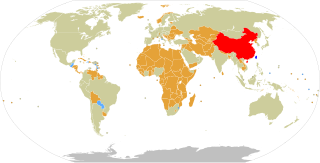
The Republic of China (ROC), often known informally as Taiwan, currently has formal diplomatic relations with 12 of the 193 United Nations member states and with the Holy See, which governs Vatican City, as of 31 December 2023. In addition to these relations, the ROC also maintains unofficial relations with 59 UN member states, one self-declared state (Somaliland), three territories, and the European Union via its representative offices and consulates under the One China principle. The government of the Republic of China has the 31st largest diplomatic network in the world with 110 offices.
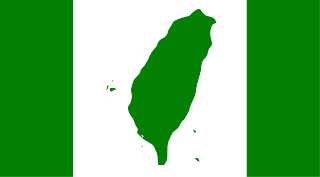
The Taiwan independence movement is a political movement which advocates the formal declaration of an independent and sovereign Taiwanese state, as opposed to Chinese unification or the status quo in Cross-Strait relations.

The Taiwan Relations Act is an act of the United States Congress. Since the formal recognition of the People's Republic of China, the Act has defined the officially substantial but non-diplomatic relations between the US and Taiwan.
The political status of Taiwan or the Taiwan issue is a long-running dispute on the political status of Taiwan, currently controlled by the Republic of China (ROC). This dispute arose in the mid-twentieth century, and is ongoing.
The term One China may refer, in alphabetical order, to one of the following:
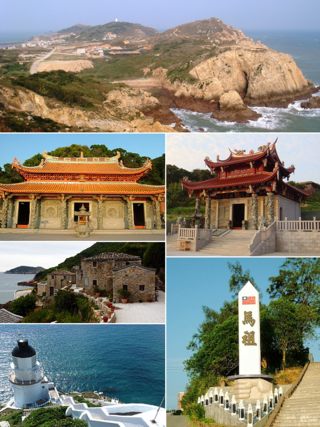
The Matsu Islands, officially Lienchiang County, are an archipelago of 36 islands and islets in the East China Sea governed by the Republic of China (Taiwan), situated alongside the southeastern coast of mainland China. The archipelago forms the smallest county in the ROC-controlled territories by area and population, as well as one of two counties that is a part of the nominal Fuchien Province.
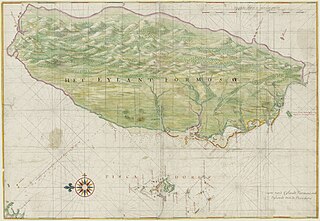
As a result of the surrender and occupation of Japan at the end of World War II, the islands of Taiwan and Penghu were placed under the governance of the Republic of China (ROC), ruled by the Kuomintang (KMT), on 25 October 1945. Following the February 28 massacre in 1947, martial law was declared in 1949 by the Governor of Taiwan, Chen Cheng, and the ROC Ministry of National Defense. Following the end of the Chinese Civil War in 1949, the ROC government retreated from the mainland as the Chinese Communist Party (CCP) proclaimed the establishment of the People's Republic of China. The KMT retreated to Taiwan and declared Taipei the temporary capital of the ROC. For many years, the ROC and PRC each continued to claim in the diplomatic arena to be the sole legitimate government of "China". In 1971, the United Nations expelled the ROC and replaced it with the PRC.

The Sino-Japanese Peace Treaty, formally the Treaty of Peace between the Republic of China and Japan and commonly known as the Treaty of Taipei, was a peace treaty between Japan and the Republic of China (ROC) signed in Taipei, Taiwan on 28 April 1952, and took effect on August 5 the same year, marking the formal end of the Second Sino-Japanese War (1937–1945).

The First Taiwan Strait Crisis was a brief armed conflict between the Communist People's Republic of China (PRC) and the Nationalist Republic of China (ROC) in Taiwan. The conflict focused on several groups of islands in the Taiwan Strait that were held by the ROC but were located only a few miles from mainland China.
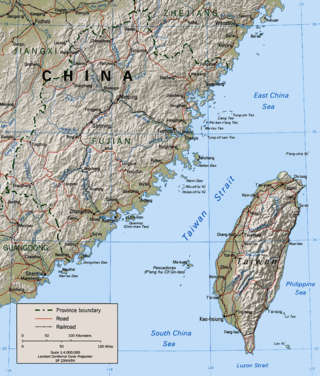
The Second Taiwan Strait Crisis, also called the 1958 Taiwan Strait Crisis, was a conflict that took place between the People's Republic of China (PRC) and the Republic of China (ROC). In this conflict, the PRC shelled the islands of Kinmen (Quemoy) and the Matsu Islands along the east coast of mainland China in an attempt to take control of Taiwan from the Chinese Nationalist Party, also known as the Kuomintang (KMT), and to probe the extent of the United States defense of Taiwan's territory. A naval battle also took place around Dongding Island when the ROC Navy repelled an attempted amphibious landing by the PRC Navy.

Cross-Strait relations are the relations between China and Taiwan.
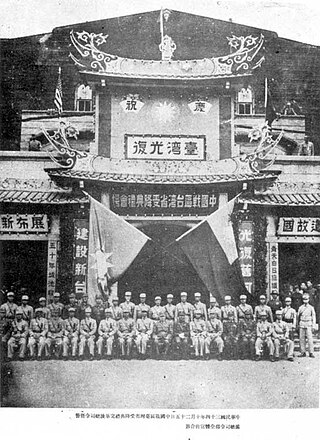
Retrocession Day is the name given to the annual observance and a former public holiday in Taiwan to commemorate the end of Japanese rule of Taiwan and Penghu, and the claimed retrocession ("return") of Taiwan to the Republic of China on 25 October 1945. However, the idea of "Taiwan retrocession" is in dispute.

The Sino-American Mutual Defense Treaty (SAMDT), formally Mutual Defense Treaty between the United States of America and the Republic of China, was a defense pact signed between the United States and the Republic of China (Taiwan) effective from 1955 to 1980. It was intended to defend the island of Taiwan from invasion by the People's Republic of China. Some of its content was carried over to the Taiwan Relations Act of 1979 after the failure of the Goldwater v. Carter lawsuit.

The complex relationship between Japan and Taiwan dates back to 1592 during the Sengoku period of Japan when the Japanese ruler Toyotomi Hideyoshi sent an envoy named Harada Magoshichirou to the Takasago Koku 高砂国 (Taiwan). The bilateral trading relations continued through the Dutch colonial rule and the Tungning Kingdom of Taiwan in 17th century before the completion of Japan's Sakoku policy. After the Meiji restoration in latter half of the 19th century, Japan resumed its expansionist ambition upon Taiwan and successfully annexed Taiwan under Japanese rule from 1895 to 1945, until the surrender of Japan after World War II. Taiwan was also surrendered by Japan to the Republic of China on 25th October 1945.

After the United States established diplomatic relations with the People's Republic of China (PRC) in 1979 and recognized Beijing as the only legal government of China, Taiwan–United States relations became unofficial and informal following terms of the Taiwan Relations Act (TRA), which allows the United States to have relations with the Taiwanese people and their government, whose name is not specified. U.S.–Taiwan relations were further informally grounded in the "Six Assurances" in response to the third communiqué on the establishment of US–PRC relations. The Taiwan Travel Act, passed by the U.S. Congress on March 16, 2018, allows high-level U.S. officials to visit Taiwan and vice versa. Both sides have since signed a consular agreement formalizing their existent consular relations on September 13, 2019. The US government removed self-imposed restrictions on executive branch contacts with Taiwan on January 9, 2021.

The following outline is provided as an overview of and topical guide to Taiwan:

Russia–Taiwan relations or Taiwan–Russia relations are the bilateral foreign relations between Taiwan and Russia. Due to the 2022 Russian invasion of Ukraine, In a 2023 survey, 95% of Taiwanese people held a negative view of Russia and China. The relations became tense after Taiwan imposed sanctions against Russia. Russia placed Taiwan on a list of "unfriendly countries", along with South Korea, Japan, Singapore, the United States, European Union members, NATO members, Canada, Australia, New Zealand, Norway, Switzerland, Micronesia and Ukraine.
The capture of the tanker Tuapse occurred on 23 June 1954, when a civilian Soviet ship was captured and confiscated by the Republic of China Navy in the high seas near the Philippines and the sailors were detained in Taiwan for various periods with three deaths, until the last four were released in 1988.














